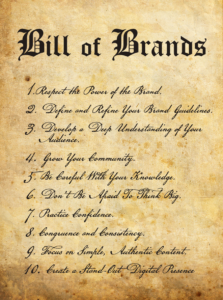10 (and a half) Essential Rules For Branding Small Businesses
Happy Independence Day! In honor of these (contractually) United States of America and the entrepreneurial spirit that defines us, we’re sharing the Bill of Brands, a list of 10 rules for branding that further define the concept of a brand and the expectations consumers place on them. These guidelines allude to timeless, authoritative brands that stand independent from their industry and are more powerful because of it. Is your small business following these 10 laws of powerful branding for small businesses?
1.Respect the Power of the Brand.
Great brands are powerful because they own key terms and imagery and have also fused with cultural norms and habits to be top-of-mind. Be the brand customers think of when they need your product or service. You need to be clear on who you are as a brand and focused on brand goals. When you respect the power of the brand, then you are motivated to take actions to develop stronger brand authority.
2. Define and Refine Your Brand Guidelines.
The brand guidelines are both the instruction manual and the spine of your brand. If you ever hire creative or strategic professionals, your brand guidelines will guide them to produce consistent, on-brand content and make decisions that align with the brand vision. At Bareknuckle we start with a client’s brand guidelines upfront with The Code, which defines the brand voice and includes sample messages, taglines, tone, key brand themes, language “rules” and more. The Code informs the visual brand guidelines, which should include the logo (including alternate logos), brand color palette, imagery, fonts, typography, icons, and other details that define the brand. Review and update brand guidelines as the brand evolves.
3. Develop a Deep Understanding of Your Audience.
It doesn’t matter how many hours and dollar signs you pump into your brand if you don’t know your audience. Successful brands understand they need their customers at least as much as customers need their products or services. Your brand is the mark of your value, and your audience expects a personalized experience as they learn about this value. Knowing your audience (and continuing to learn about them) will help you adapt to their needs, which benefits everyone.
4. Grow Your Community.
Community is oxygen to your brand. A healthy, expanding network shows your brand thinks beyond itself. Be resourceful and authentic with available tools to grow and nurture the community that supports your brand vision. Contribute to your community and the corners of the world that benefit most from your value. Your community includes your customers, followers, and employees. Your community also includes complimentary brands that may share your primary client base or that stand for similar values.
5. Be Careful With Your Knowledge.
Data analytics and other technologies have made personal information cake to acquire. That kind of power should not be taken lightly. Learn to effectively convey relevant information and use knowledge only to add value for your audience. Also, don’t forget to respect those very real GDPR privacy laws.
6. Don’t Be Afraid To Think Big.
Success is confined by size of our dreams … so why wouldn’t you think big? In the global marketplace, there’s no reason why a small business shouldn’t be thinking globally. Even if you are a micro-business, thinking big shatters the illusion of “good enough.” Burst through the ceiling of your okayest dreams and get comfortable aiming high.
7. Practice Confidence.
To gain brand authority, you have to exude confidence. Entrepreneurship is a constant exploration. If you’re starting a small business the odds are everything that steps in front of you will be new. Have confidence in yourself that you can tackle these things, take risks, and also accept what you don’t know.
8. Congruence and Consistency.
One way to destroy customer loyalty is to make things too confusing, too difficult, or too inconsistent. Do what you say you’re going to do and do it consistently.
9. Focus on Simple, Authentic Content.
If a potential customer doesn’t understand what value you can provide to them in 10 seconds, then you need to take time to clean up and simplify. If things get wordy, then it will appear as though you’re either unsure of what you offer or you’re lying through your toothy smile. The words flow easier when they’re coming from a place of authenticity.
10. Create a Stand-Out Digital Presence.
This is your digital storefront (and for e-commerce, your only storefront). It’s how your audience dives deeper into your brand. This is your home, welcome them in.
Bonus Bill – (Bareknuckle’s favorite Bill of Brands)
Happy Independence Day From Bareknuckle! Now get out there, follow these rules for branding, and wave that entrepreneurial flag (or the American flag, whatever).




Recent Comments